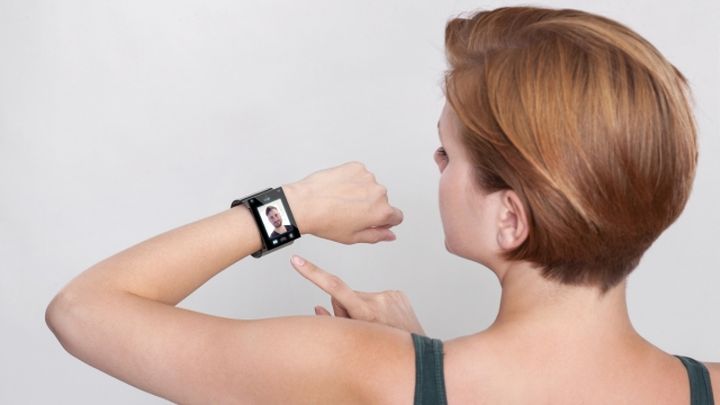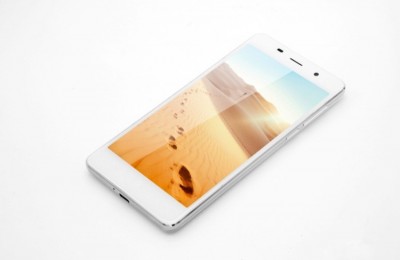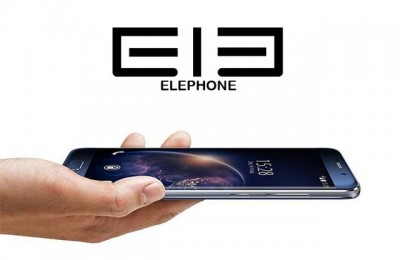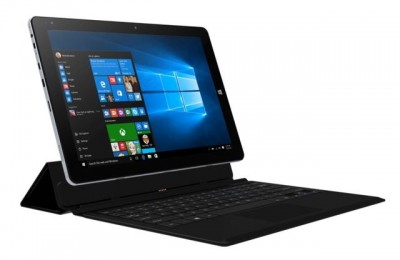“All my carry with me,” – said 2500 years ago, the Sage of Priene. Although a good backpack can accommodate up to two pounds new potatoes or apples, much nicer if useful for human belongings compact and EASY. A better – and you do not notice until it is used.
The very first transportable gadget was probably the laptop. Invented back in the era of huge computers, it is pleased by the fact that he could be moved from place to place by one person. However, laptops have long been a sort of “thing in itself”, complicated ways punching position in the mass market. Initially, it is hampered by the size, and then – the cost, up to the 2000s, remained at the level twice higher than that of PC identical configuration.
Technology fracture occurred at a time when the LCD screens have become quite cheap to manufacture and miniaturization of components has ceased to play a major role in pricing. These factors have made laptops temporary kings of the market of portable devices, they also served as a prerequisite revolution allowed to occupy the throne of the tablet.
List of laptops and tablets would not be complete if we did not remember about smartphones. Long overcoming stage niche product under the guise of the CCP and “communicators”, they got their chance thanks to the efforts of designers and programmers Apple, combine comfort finger touch input with the simplicity of the operating system iOS.
Anyway, despite the success, laptops, tablets, and smartphones still do not fully meet the needs of people in the mobility and portability. For all their ease and miniature, people still had to wonder how he will place the gadget where it should be, how it will be convenient to him on the road.
It happened in the long history that these issues do not arise in people to three things: clothes, jewelry and wristwatches. It was this trio has become a model for the creation of gadgets “new generation” – to keep “insensible” wear.
T-shirt instead of a smartphone
As mentioned above, creating a laptop, tablet and smartphone manufacturers have decided to reduce the size of the problem and cost, as well as looking for ways to simplify the interface due to the software and network infrastructure.
Turning to the production of “smart” watches, jewelry and clothing, they are faced with new challenges. However, in the case of the clock – there are familiar problems. The same miniaturization. Make a complete, though fairly simple, the computer in the usual dimensions watch case still remains a nontrivial task: CPU, memory chips, sensors – all of them have very consciously placed inside the thinnest smartphone, but with the elegance of modern wristwatches until coexist mediocrely.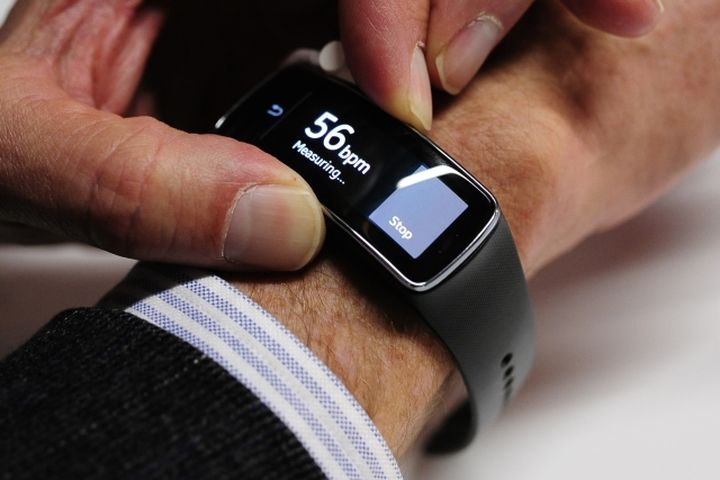
In this sense, thinner and lighter “smart” bracelets, pendants and pendants makes it much easier: they are replaced by a simple controller CPU and the main functions are assigned to the sensors.
However, watches and bracelets so far run into one technological obstacle – the battery capacity. Impressively long work can not yet boast even batteries of smartphones and tablets, however, for watches and bracelets current ratio of the size of the battery to its ability to store energy frankly looks bleak.
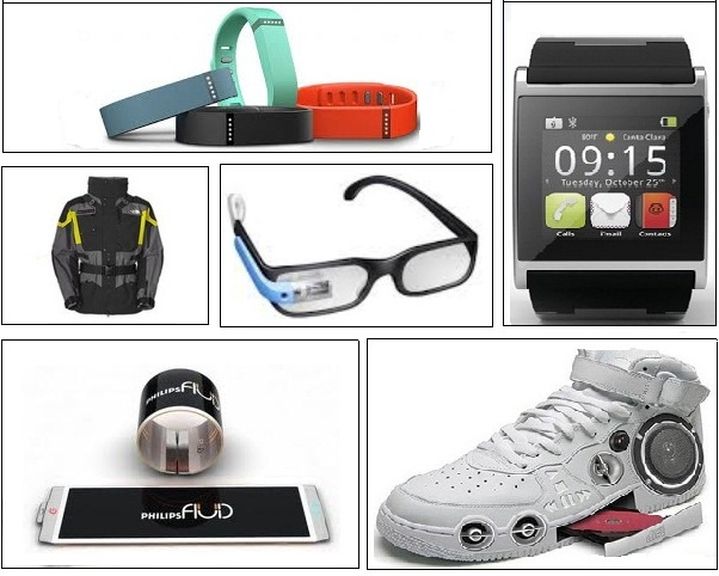
“Smart” clothing (including shoes and) complex in the production that is only now beginning to emerge electronic circuits and components, flexibility is comparable with fabric or leather. In addition, this kind of “gadgets” also suffers from imperfections energy batteries. Finally, do not fully built infrastructure to “smart” shirt and shorts turn from the experimental trends in useful thing.
Nevertheless, the development of wearable gadget goes on as usual. Already one. Not two, but dozens of companies offering mass-market samples of such devices. About the most interesting of them, promising and successful today and we want to tell.
Wireless headphones Jabra Pulse
One of the main functions supported by an absolute majority of wearable gadgets – hours and bracelets – is the measurement of the pulse. This option is considered to be the base for the sports use of the device, namely its support formally allows the use of the name prefix “smart.”
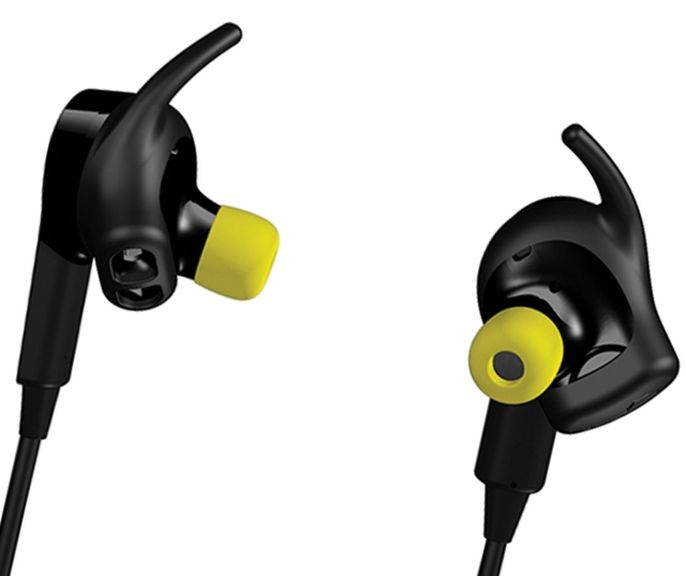
Metering pulse in the sports bracelet tracker seems a natural solution. In the smart-hours, it is due to the versatility of the device. However, the obvious solution – add this feature earphone – for some reason the engineers came up with only one company: Jabra.
Headphones Jabra Pulse – wireless devices. They need to work synchronized with your smartphone or tablet, which is used as a sound source. Communication channel – Bluetooth. Through the same Bluetooth headphones are sent to a special application data on the pulse.
The sensor is integrated into the heart of the earphone, which is directly in the ear. According to engineers Jabra, this arrangement allows to obtain the most accurate results from the point of view of modern medicine. By the way, the sensors Jabra uses a third-party that certifies them as “for clinical use.”
Receiving data, the application Jabra Pulse can keep a log of changes, presenting it as a graph. The application also allows you to calculate the distance that people ran (or walked) during training and on the basis of this information to obtain the index of oxygen consumption VO2 max.
Built-in battery Headphone allows them to work for five hours. Unfortunately, no power saving mechanisms – for example, by switching off the sensor heartbeat – a Jabra Pulse it provided.
Set Athos
Sensors that measure the physiological activity of the body and can be set in hours, and bracelets, and headphones. However, for the complete collection of information, they still have to be distributed over the entire surface of the body – which means are integrated into clothing.
Further, in the other direction the company has advanced Athos, which presented its own brand set of t-shirts, shorts and device-clothespins Core, performing the role of a “think tank”.
In Core installed six-axle acceleration sensor module and Bluetooth, collects data from sensors clothes and send them to the smartphone.
The clothes are available: a T-shirt – 12 sensors electromagnetic activity, 2 sensor heartbeat sensor and 2 breathing; shorts – 8 sensors electromagnetic activity and heartbeat sensor 4. All this together makes it possible to draw a firmware application load balancing scheme, highlight the working muscles in real time, as well as to determine – in what tone they are. In addition to the logging heartbeat application, Athos fixes the rate of recovery of rhythm to normal parameters, follow the proper breathing during exercise, and so on.
Sensor-clothespin Stryd
While the rest of the smart device-oriented sports, and increase the number of parameters to be read from the sensors and complicate the flow of the obtained results, the sensor-clothespin Stryd aims at identifying one, universal and common performance characteristics – in this case the run.
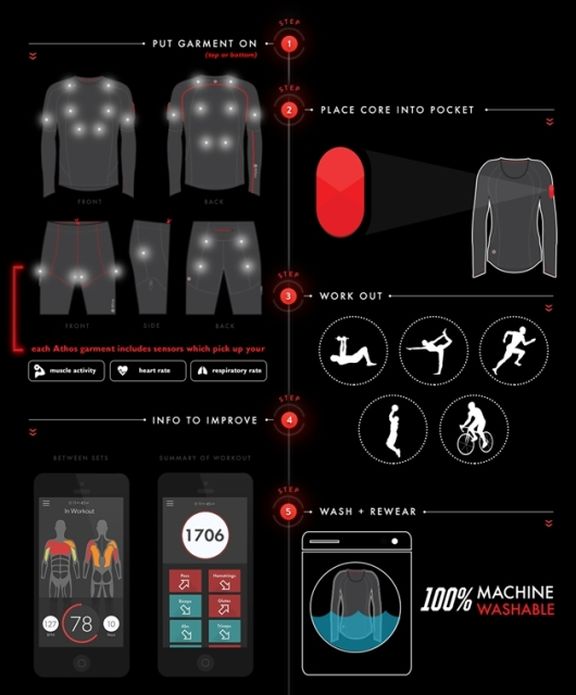
Developers call Stryd «the world’s first portable device for measuring power running” – and used to offer training effectiveness “good old days” Watts. Their choice, they explain the fact that Watts – after all – the official unit of the international system of SI, and the fact that the heart rate and breathing rate may vary from individual to individual and environment.
Calculation load in Watts depends on the speed and force spent. Their Stryd measured by a system of sensors that detect changes in the three-dimensional position of the runner system of coordinates. It takes into account not only the speed, but also a change in the landscape – including the most minor nuances cover (sensors allow for the speed of the feet touch the surface).
Stryd collected information can be transmitted to the smart watch or tablets – to the runner could see a real-time change in the load, and save the log and sent to a computer, a special analysis program.
Bracelet-screen Bracelet
By smart bracelets, many have become accustomed, clearly presenting the device as a gadget packed with sensors of physical activity. Bracelets are good because they have a simple and compact design, which leaves plenty of rooms to select the shape, material and color of the strap.
With this simplification functions bracelets fundamentally disagrees French company Circuit, which sees them as the gadget is very conveniently located for projection on the back of your wrist some pictures.
Their bracelet Cicret Bracelet, perhaps not too surprising design, as engineers could not afford to change the space in the building for a cheerful color strap. But essentially this bracelet – a real microcomputer with built-in pico-projector and a camera, rangefinder, a reading by touch.
Due to the fact that in the case Cicret Bracelet has everything you need: processor, memory, port USB, memory card slot, communication modules and battery, the device does not need a companion from among the smartphones and tablets.
Currently, engineers Cicret have on hand a working prototype, which they want to bring to the state of the commercial product to the beginning of 2016. At the moment, it is proved that the gadget works fine (projects the image and determines the right touch) for people of all skin colors and in all lighting conditions.
Endless battery
At the beginning of this article, we mentioned that the issue of power very for wearable gadgets: laptops, tablets, smartphones. However, in the case of a smart watches, bracelets, pendants and smart clothes everything is more complicated and easier at the same time.
On the one hand, place the battery capacity in decent housing chronometer or belt shorts difficult.
But on the other – wearable gadgets “new generation” at all may not need battery. After all, they have direct contact with the battery a huge carrying capacity – the human body.
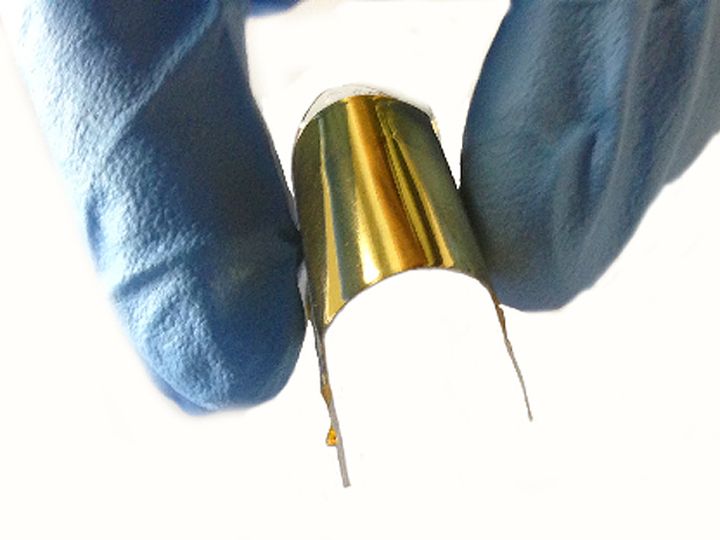
Technology of extracting energy from the human body and its transfer to wearable devices already being actively developed. Currently, the greatest success achieved at the National University of Singapore. His staff managed to create flexible power generator the size of a sweat mark. The generator consists of two flexible layers of gold and silicon gasket therebetween. The thickness of the gold layer – only 50 nanometers. That’s enough to touch the surface of the generator when exposed skin it begins to generate currents with the potential 7.3-7.5 volts. Currently a generator allows you to use the human body as a battery for 12 LEDs.
Read another very interesting article about alternative energy of the Sun, water and air.

